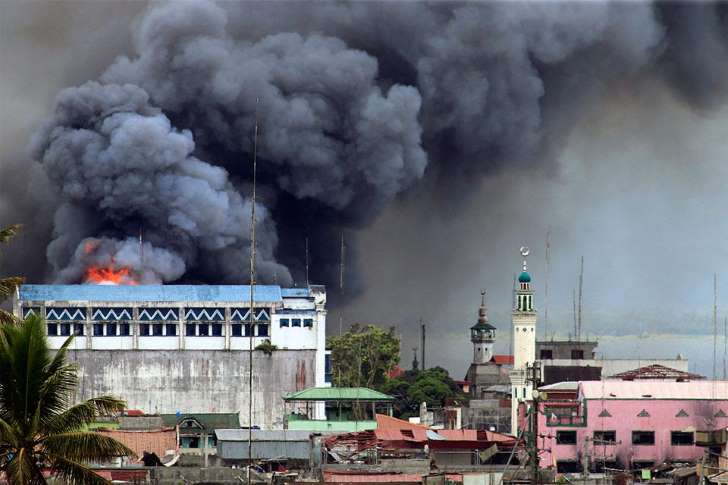
Boming on Marawi City.
“Marawi showed all potential enemies the advantages of urban warfare [for insurgents].”
The Filipino publication mindanews.com recently published the excerpted article featuring portions from a book by Filipino author Gail Ilagan about the 2017 occupation of Marawi, Mindanao by up to 2,000 militants loyal to the Islamic State (IS) and the military’s recapture of the city. The article recounts details of the occupation, noting that the trigger of the occupation was the Philippine army’s attempt to capture the militants’ leader, Isnon Hapilon. Unbeknownst to the army, the militants had already established sleeper cells in Marawi that they activated once the operation to capture Hapilon began, including attacking a prison to release group members, bombing a church, and sending fighters to control university campuses.[i]
The article points to missteps by the army, including interpreting the militants to be local fighters when, in fact, they not only had inspiration from IS, but also had invited foreign IS supporters to Mindanao and employed IS tactics. In addition, Philippine security forces overlooked earlier bombings at night markets near universities and occupations of smaller towns in Mindanao, which had displaced residents and should have been seen as a harbinger of the future occupation of the much larger city of Marawi. Ultimately, the article claims the military’s unpreparedness resulted in more soldiers’ lives lost than necessary. Military equipment, such as tanks, were unsuitable for maneuvering Marawi’s narrow alleyways, while the insurgents’ hijacking of fire trucks and other public vehicles made it difficult for soldiers to identify their adversaries in the urban combat environment. However, the article concludes that hard lessons were learned from the siege of Marawi that make a similar insurgent takeover unlikely in the near term.[ii] The military has changed its organizational structure, acquired new equipment, and improved training methods to prepare for urban warfare.
Source:
“Local Frontlines of Globalized Islamic States Network: The Emerging War Arena for the Filipino Soldier,” mindanews.com (regional newspapers focusing on Mindanao), 16 October 2022. https://www.mindanews.com/top-stories/2022/10/local-frontlines-of-globalized-islamic-states-network-the-emerging-war-arena-for-the-filipino-soldier/
Violent extremists are rare among Muslim Filipinos. However, it does not take a lot of them to cause a scale of destruction such as was seen in the aftermath of the 2017 Marawi Siege.
Among its choices, the region of Mindanao seemed to be most appealing [to ISIS] because of its porous maritime boundaries and the safe haven that local extremist groups could provide. One such local extremist group was the Basilan-based Abu Sayyaf Group (ASG) that had pledged allegiance to ISIS and Abu Bakr al-Baghdadi in June 2014. In 2016, al-Baghdadi accepted the Abu Sayyaf’s pledge and appointed ASG commander Isnilon Hapilon as the ISIS’ emir in Southeast Asia. Hapilon and his soldiers traveled soon after to Marawi where they were embraced by the Maute Group, as well as other local terrorist groups that shared the ISIS’ aspiration.
The Marawi Crisis was ignited in the early afternoon of 23 May 2017 when security forces tried to arrest Hapilon in Barangay Basak Malutlut in Marawi City. It was two days before the Muslim holiday of Eid’l Fitr. Intelligence sources would later reveal that the ISIS-inspired groups intended to mark Eid’l Fitr by taking over the only Islamic city in the Philippines and declaring it ISIS territory. At the time when the security team was sent to Marawi with the warrant of arrest, they were unaware that Hapilon’s forces were positioned in the adjoining buildings, ready to defend their leader. The arresting team immediately came under heavy fire as soon as they entered the narrow street where Hapilon’s quarters were located.
It would take five long months for the government to neutralize the extremists and rid Marawi of them.
Notes:
[i] In mid-2014, the longtime Abu Sayyaf commander Isnon Hapilon and around a dozen other militants released a video pledging allegiance to IS leader Umar al-Baghdadi. Hapilon noted in the video that these militants and other factions had made pledges separately but were now coming together, which signaled the unification of Abu Sayyaf factions and set the stage for the group’s eventual attack on Marawi under the leadership of the Maute Brothers and Hapilon, all of whom were killed during the battle. See: Jacob Zenn, “The Islamic State’s Provinces on the Peripheries: Juxtaposing the Pledges from Boko Haram in Nigeria and Abu Sayyaf and Maute Group in the Philippines.” Perspectives on Terrorism, vol. 13, no. 1, 2019, pp. 87–104.
[ii] The restoration of critical infrastructure in Marawi and the return of the city’s inhabitants to their original homes, which were destroyed during the battle in 2017, has been slow. This has also raised concerns that grievances of the local population regarding their treatment in post-conflict Marawi could result in their supporting antigovernment militant groups in the future or their remaining alienated from the government, which was one of the reasons why Abu Sayyaf was initially able to gain some traction from among the youths in Marawi. See: Jacob Zenn, “Marawi Rehabilitation Progress Slows in the Philippines,” OE Watch, July 2018. https://community.apan.org/wg/tradoc-g2/fmso/m/oe-watch-articles-singular-format/277112
Image Information:
Image: Boming on Marawi City.
Source: Mark Jhomel https://commons.wikimedia.org/wiki/File:Bombing_on_Marawi_City.jpg
Attribution: CC BY 4.0
